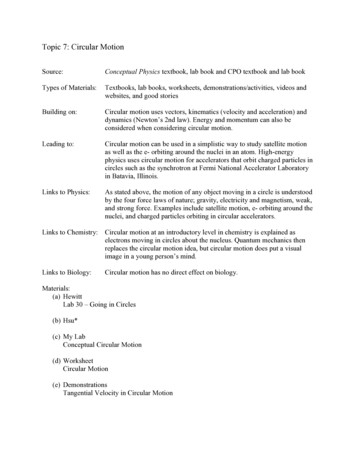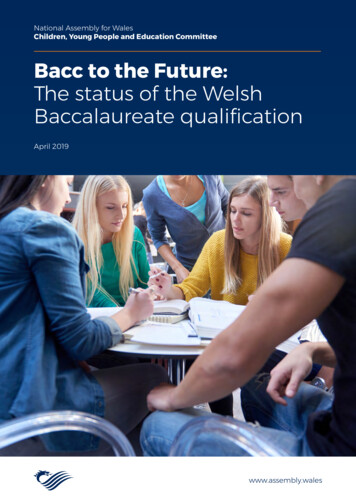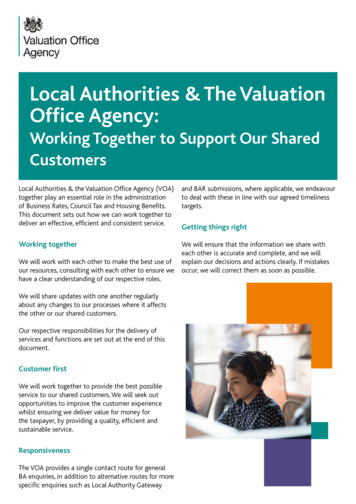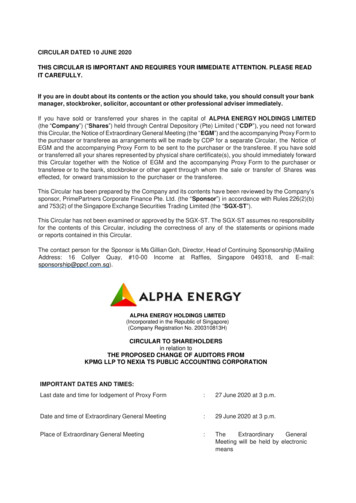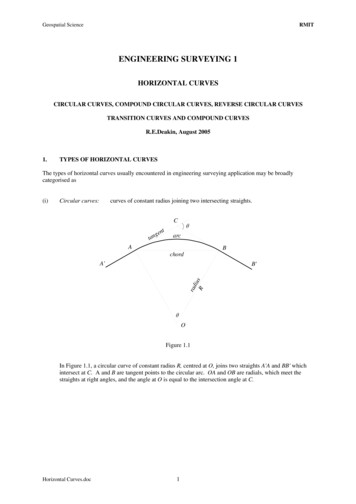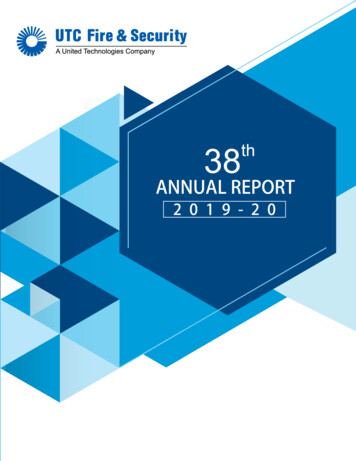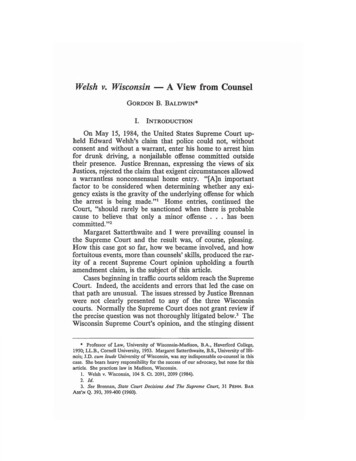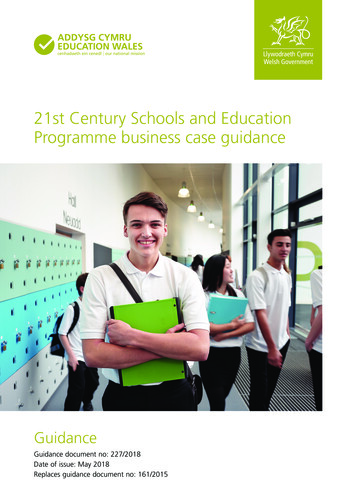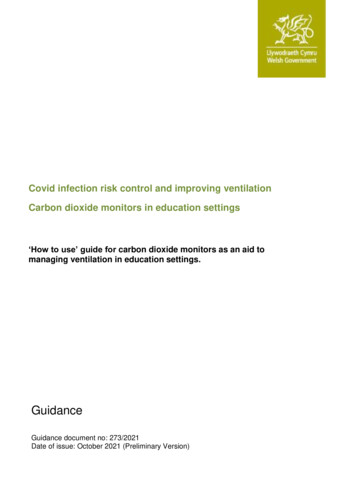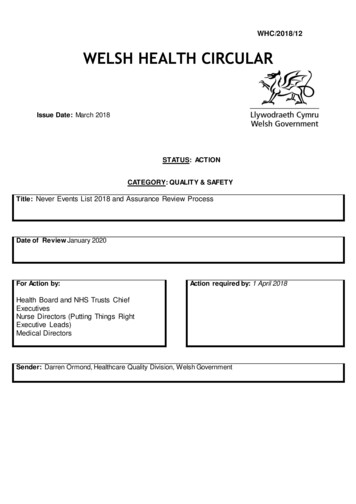
Transcription
WHC/2018/12WELSH HEALTH CIRCULARIssue Date: March 2018STATUS: ACTIONCATEGORY: QUALITY & SAFETYTitle: Never Events List 2018 and Assurance Review ProcessDate of Review January 2020For Action by:Action required by: 1 April 2018Health Board and NHS Trusts ChiefExecutivesNurse Directors (Putting Things RightExecutive Leads)Medical DirectorsSender: Darren Ormond, Healthcare Quality Division, Welsh Government
DHSS Welsh Government Contact(s) :Darren OrmondHealthcare Quality DivisionWelsh GovernmentCathays ParkCardiffCF10 3NQTel: 03000255621Enclosure(s): Never Events List 2018
Never Events List 2018 and AssuranceReview Process1
FOREWORDDear Colleagues,This document confirms the revised list of reportable patient safety incidents to beclassed as Never Events from 1April 2018 . This supersedes the previous listpublished in 2015 and applies to all NHS Wales’ health boards and trusts. Therevised document includes the addition of two new Never Events. These are: Unintentional connection of a patient requiring oxygen to an airflowmeterUndetected oesophageal intubationI would also like to inform you of a change in the routine follow up actions requiredfollowing a Never Event reported in Wales.You will be aware that from October 2014 the Delivery Unit (DU) was asked to carryout assurance reviews of each Never Event reported by NHS organisations to WelshGovernment. This request followed presentation of data which demonstrated asignificant delay in managing never events to closure and a lack of national learning.Since this time, the DU has provided extensive feedback to organisations on theirmanagement of these incidents. This has helped improve many NHS organisations’arrangements for the timely management of the incident along with robustinvestigation processes in order to achieve maximum learning. However, it wasnever intended that DU support would continue long term.Given the improvements that have been seen and the DU resource deployed for thispurpose, we have agreed the current process discontinue from 1 April 2018.Incidents where the assurance review is ongoing will continue to completion.Going forward the DU may still be asked to work with organisations on an exceptionbasis in respect of reported serious incidents, including Never Events shouldproblems with assurance of learning occur or in order to maximise opportunities forsystem wide learning.Yours sincerelyDR CHRIS JONES2
NEVER EVENTS LIST 2018IntroductionNever Events are defined as Serious Incidents that are wholly preventable becauseguidance or safety recommendations are available at a national level and shouldhave been implemented by all healthcare providers.Each Never Event type has the potential to cause serious patient harm or death.However, serious harm or death does not need to have happened as a result of aspecific incident for that incident to be categorised as a Never Event .Never Events require full investigation under the Serious Incident framework. Thisincludes the need to fully and meaningfully engage patients, families and carers atthe beginning of and throughout any investigation.Learning from what goes wrong in healthcare is crucial to preventing future harm.Surgical1. Wrong site surgeryAn invasive procedure1 performed on the wrong patient or at the wrong site (e.g.wrong knee, eye, limb, tooth). The incident is detected at any time after the start ofthe procedure.Includes: Interventions that are considered to be surgical but may be done outside asurgical environment – for example, wrong site block (including blocks for painrelief), biopsy, interventional radiology procedure, cardiology procedure, draininsertion and line insertion (e.g. peripherally inserted central catheter (PICC)/Hickman lines). This also includes teeth extracted in error that are immediatelyreimplanted.Excludes: removal of wrong primary (milk) teeth unless done under a generalanaestheticinterventions where the wrong site is selected because the patient hasunknown/unexpected anatomical abnormalities; these should be documentedin the patient’s noteswrong level spinal surgery*wrong site surgery due to incorrect laboratory reports/results or incorrectreferral letterscontraceptive hormone implant in the wrong arm.1The start of an invasive procedure is when a patient’s anatomy begins to be permanently altered. Forexample, this is when the first incision is made that will scar the patient and take time to heal and recoverfrom.3
* Excluded from the current list while work is underway with NHS Improvement andthe relevant professional organisations to ensure development of robust nationalbarriers to prevent this incident.Setting: All settings providing NHS-funded care.National safety requirement: Safer Practice Notice – Wristbands for hospital inpatients improves safety(2005). The key points are summarised in Recommendations from NationalPatient Safety Agency alerts that remain relevant to the Never Events list.Safer Practice Notice – Standardising wristbands improves patient safety(2007). The key points are summarised in Recommendations from NationalPatient Safety Agency alerts that remain relevant to the Never Events list.Patient Safety Alert – WHO surgical safety checklist (2009). The key points inthe alert are summarised in Recommendations from National Patient SafetyAgency alerts that remain relevant to the Never Events list.Safe Anaesthesia Liaison Group – Stop before you block (2011).The Royal College of Radiologists – Standards for providing a 24 hourinterventional radiology service (2008).Faculty of Pain Medicine – Safety checklist for interventional pain proceduresunder local anaesthesia or sedation (2017).Royal College of Surgeons (Faculty of General Dental Practice) – Toolkit forthe prevention of wrong tooth extraction (2017).Wales Deanery (Dental Section) – Mouthcare pre-extraction checklist (2017).National safety standards for invasive procedures (NatSSIPs) (2016).Patient Safety Notice – Supporting the introduction of the National SafetyStandards for Invasive Procedures (2016).2. Wrong implant/prosthesisPlacement of an implant/prosthesis different from that specified in the proceduralplan, either before or during the procedure. The incident is detected any time afterthe implant/prosthesis is placed in the patient.Excludes: placed implant/prosthesis is intentionally different from that specified in thesurgical plan, based on clinical judgement at the time of the procedurespecified implant/prosthesis is placed as planned but later found to besuboptimalimplant/prosthesis is different from the one specified due to incorrectpreprocedural measurements or incorrect interpretation of the preproceduraldata – for example, wrong intraocular lens placed due to wrong biometry orusing wrong dataset from correct biometry.4
Includes: implantation of an intrauterine contraceptive device different from the one inthe procedural plan.See Appendix A for examples of correct application of this Never Event definition.Setting: All settings providing NHS-funded care.National safety requirement: Safer Practice Notice – Wristbands for hospital inpatients improves safety(2005). Key points are summarised in Recommendations from NationalPatient Safety Agency alerts that remain relevant to the Never Events list.Safer Practice Notice – Standardising wristbands improves patient safety(2007). Key points are summarised in Recommendations from NationalPatient Safety Agency alerts that remain relevant to the Never Events list.Patient Safety Alert – WHO surgical safety checklist (2009). Key points aresummarised in Recommendations from National Patient Safety Agency alertsthat remain relevant to the Never Events list.National safety standards for invasive procedures (NatSSIPs) (2016).Patient Safety Notice – Supporting the introduction of the National SafetyStandards for Invasive Procedures (2016).3. Retained foreign object post procedureRetention of a foreign object in a patient after a surgical/invasive procedure.‘Surgical/invasive procedure’ includes interventional radiology, cardiology,interventions related to vaginal birth and interventions performed outside the surgicalenvironment – for example, central line placement in ward areas.‘Foreign object’ includes any items subject to a formal counting/checking process atthe start of the procedure and before its completion (such as for swabs, needles,instruments and guidewires) except where items: not subject to the formal counting/checking process are inserted any timebefore the procedure, with the intention of removing them during theprocedure but they are not removedsubject to the counting/checking process are inserted during the procedureand then intentionally retained after its completion, with removal planned for alater time or date as clearly recorded in the patient’s notesare known to be missing before completion of the procedure and may beinside the patient (e.g. screw fragments, drill bits) but action to locate and/orretrieve them is impossible or more damaging than retention.See Appendix B for examples of correct application of this Never Event definition.Setting: All settings providing NHS-funded care.5
National safety requirement: Patient Safety Alert – WHO surgical safety checklist (2009). Key points aresummarised in Recommendations from National Patient Safety Agency alertsthat remain relevant to the Never Events list.Safer Practice Notice – Reducing the risk of retained throat packs aftersurgery (2009). Key points are summarised in Recommendations fromNational Patient Safety Agency alerts that remain relevant to the NeverEvents list.Patient Safety Alert – Reducing the risk of retained swabs after vaginal birthand perineal suturing (2010). Key points are summarised inRecommendations from National Patient Safety Agency alerts that remainrelevant to the Never Events list.National safety standards for invasive procedures (NatSSIPs) (2016).Patient Safety Notice – Supporting the introduction of the National SafetyStandards for Invasive Procedures (2016).Medication4. Mis-selection of a strong potassium solutionMis-selection refers to: when a patient is intravenously given a strong 2 potassium solution rather thanthe intended medication.Setting: All settings providing NHS-funded care.National safety requirement: Patient Safety Alert – Potassium chloride concentrate solutions (2002;updated 2003). Key points are summarised in Recommendations fromNational Patient Safety Agency alerts that remain relevant to the NeverEvents list.5. Administration of medication by the wrong routeThe patient is given one of the following: intravenous chemotherapy by the intrathecal route oral/enteral medication or feed/flush by any parenteral route intravenous medication that was intended to be administered by the epiduralroute.Setting: All settings providing NHS-funded care.2 10% pota ssium w/v (e.g. 0.1 g/mL potassium chloride, 1.3 mmol/mL potassium chloride).6
National safety requirement: Patient Safety Alert – Promoting safer measurement and administration ofliquid medicines via oral and other enteral routes (2007). Key points aresummarised in Recommendations from National Patient Safety Agency alertsthat remain relevant to the Never Events list.Patient Safety Alert – Safer practice with epidural injections and infusions(2007). Key points are summarised in Recommendations from NationalPatient Safety Agency alerts that remain relevant to the Never Events list.Patient Safety Alert – Update to National Patient Safety Agency (NPSA) alertfor safer spinal (intrathecal), epidural and regional devices (2016).Patient Safety Notice – Managing risks during the transition period to new ISOconnectors for medical devices used for enteral feeding and neuraxialprocedures (2015).6. Overdose of insulin due to abbreviations or incorrect deviceOverdose refers to when: a patient is given a 10-fold or greater overdose of insulin because the words‘unit’ or ‘international units’ are abbreviated; such an overdose was given in acare setting with an electronic prescribing system3 a healthcare professional fails to use a specific insulin administration device –that is, an insulin syringe or pen is not used to measure the insulin a healthcare professional withdraws insulin from an insulin pen or pen refilland then administers this using a syringe and needle.Setting: All settings providing NHS-funded care.National safety requirement: Rapid Response Report – Safer administration of insulin (2010). Key pointsare summarised in Recommendations from Recommendations from NationalPatient Safety Agency alerts that remain relevant to the Never Events list.Patient Safety Alert – Ensuring the Safe Administration of Insulin (2016).3El ectronic prescribing, dispensing a nd a dministration s ystems a re an evidence-based method to reduce patient harmfrom medicines. All NHS organisations should i ntroduce them as soon a s possible. When th e definitions for the insulin a ndmethotrexate overdose Never Events were revised in 2015, i t was agreed that those for i nsulin given in overdose becauseof the us e of a bbreviations for ‘unit’ and for a ll methotrexate overdose incidents would only a pply to ca re s ettings withel ectronic prescribing s ystems as i ndicated. The s ystemic protective barriers for these two types of Never Event werefound not to be s trong enough in care s ettings where electronic barriers do not exist. For example, even though mosta cute hospitals do use a preprinted insulin prescri ption to try a nd prevent prescribers using the a bbreviations ‘i u’ or ‘u’,thi s is not the ca se in a ll ca re settings. Also, preprinted prescriptions on their own are not a reliably strong enough barri erto prevent a potential 10-fold dosing error a s prescribers can still prescribe insulin on general prescriptions.7
7. Overdose of methotrexate for non-cancer treatmentOverdose refers to when: a patient is given a dose of methotrexate, by any route, for non-cancertreatment that is more than the intended weekly dose; such an overdose wasgiven in a care setting with an electronic prescribing system. 3Setting: All settings providing NHS-funded care.National safety requirement: Patient Safety Alert – Improving compliance with oral methotrexate guidelines(2006). Key points are summarised in Recommendations from NationalPatient Safety Agency alerts that remain relevant to the Never Events list.8. Mis-selection of high strength midazolam during conscious sedationMis-selection refers to when: a patient is given an overdose of midazolam due to the selection of a highstrength preparation (5 mg/mL or 2 mg/mL) instead of the 1 mg/mLpreparation, in a clinical area performing conscious sedation excludes clinical areas where the use of high strength midazolam isappropriate; these are generally only those performing general anaesthesia,intensive care, palliative care, or areas where its use has been formally riskassessed in the organisation.Setting: All settings providing NHS-funded care.National safety requirement: Rapid Response Report – Reducing risk of overdose with midazolam injectionin adults (2008). Key points are summarised in Recommendations fromNational Patient Safety Agency alerts that remain relevant to the NeverEvents list.Mental health9. Failure to install functional collapsible shower or curtain railsInvolves either: failure of collapsible curtain or shower rails to collapse when an inpatientattempts or completes a suicide failure to install collapsible rails and an inpatient attempts or completes asuicide using non-collapsible rails.Setting: All settings providing NHS-funded mental health inpatient care.8
National safety requirement:Health building notes: Welsh Health building note 03-01 – Adult acute mental health units (2016).Health building note 03-02 – Facilities for child and adolescent mental healthservices (CAMHS) (2017).Estates and facilities alerts: NAfW Safety Action Bulletin (2002) 02 – Cubicle rail suspension system withload release support systems (2002).NHS Estates Alert (2004)03 – G-rail 2301, window curtain tracking system(2004).NHSEstates Hazard Notice (2004)06 – Cubicle rail tracking and PVCdustcovers (2004).NHS Estates Hazard Notice (2004) 08 – Bed cubicle rails, shower curtainsrails, and curtain rails in psychiatric in-patient settings (2004).WAG DH Estates & Facilities Alert (2007)08 – Cubicle curtain track rail(2007).EFA/2010/003 – Anti-ligature curtain rails (including shower curtains): Risksfrom incorrect installation or modification (2010).EFA/2010/10 – Flush fitting anti-ligature curtain rails: ensuring correctinstallation (2010).General10. Falls from poorly restricted windowsA patient falling from a poorly restricted window4. This applies to: windows ‘within reach’ of patients; this means windows (including the windowsills) that are within reach of someone standing at floor level and that can beexited/fallen from without needing to move furniture or use tools to climb outof the window windows located in facilities/areas where healthcare is provided and thatpatients can and do access where patients deliberately or accidentally fall from a window where a fittedrestrictor is damaged or disabled, but not where a patient deliberately disablesa restrictor or breaks the window immediately before they fall where patients can deliberately overcome a window restrictor using theirhands or commonly available flat-bladed instruments as well as the ‘key’provided.Setting: All settings providing NHS-funded care.4This includes windows where the provider has not put a restrictor in place in accordance with guidance.9
National safety requirement: Welsh Health Building Note 00-10 Part D – Windows and associatedhardware (2014).Department of Health Estates and Facilities Alert – Window restrictors ofcable and socket design (2014).Health and Safety Executive Risk of falling from windows (2016).11. Chest or neck entrapment in bed railsEntrapment of a patient’s chest or neck between bedrails or in the bedframe ormattress, where the bedrail dimensions or the combined bedrail, bedframe andmattress dimensions do not comply with Medicines and Healthcare productsRegulatory Agency (MHRA) guidance.Setting: All settings providing NHS-funded care including care homes, and patients’own homes where equipment for their use has been provided by the NHS.National safety requirement: Medicines and Healthcare products Regulatory Agency – Safe use of bedrails (2013).12. Transfusion or transplantation of ABO-incompatible blood components ororgansUnintentional transfusion of ABO-incompatible blood components.Excludes: where ABO-incompatible blood components are deliberately transfused withappropriate management.Unintentional ABO-mismatched solid organ transplantation.Excludes: situations in which clinically appropriate ABO-incompatible solid organs aredeliberately transplanted.In this context, ‘incompatible’ antibodies must be clinically significant. If the recipienthas donor-specific anti-ABO antibodies and is therefore likely to have an immunereaction to a specific ABO-compatible organ, the inadvertent transplantation of thatorgan without appropriate management is a Never Event.Setting: All settings providing NHS-funded care.10
National safety requirement: Patient Safety Notice – Safe transfusion practice: use a bedside checklist(2018).British Society for Histocompatibility and Immunogenetics and BritishTransplantation Society – Guidelines for the detection and characterisation ofclinically relevant antibodies in allotransplantation (2014).British Transplantation Society – Guidelines for antibody incompatibletransplantation (2015).Safer Practice Notice – Wristbands for hospital inpatients improves safety(2005). Key points are summarised in Recommendations from NationalPatient Safety Agency alerts that remain relevant to the Never Events list.Safer Practice Notice – Standardising wristbands improves patient safety(2007). Key points are summarised in Recommendations from NationalPatient Safety Agency alerts that remain relevant to the Never Events list.13. Misplaced naso- or oro-gastric tubesMisplacement of a naso- or oro-gastric tube in the pleura or respiratory tract that isnot detected before starting a feed, flush or medication administration.Setting: All settings providing NHS-funded care.National safety requirement: Patient Safety Alert – Nasogastric tube misplacement: continuing risk of deathand severe harm (2017).NHS Improvement – Initial placement checks for nasogastric and orogastrictubes: resource set (2016).Patient Safety Notice – Placement devices for nasogastric tube insertion DONOT replace initial position checks (2014).14. Scalding of patientsPatient scalded by water used for washing/bathing.Excludes: scalds from water being used for purposes other than washing/bathing (e.g.from kettles).Setting: All settings providing NHS-funded care.National safety requirement: WHTM 04-01 – Safe water in healthcare premises (2006, updated 2016).WHealth Building Note 00-10 Part C – Sanitary assemblies (2014).11
Health and Safety Executive – Managing the risks from hot water andsurfaces in health and social care (2012).Health and Safety Executive – Scalding and burning (2012).15. Unintentional connection of a patient requiring oxygen to an air flowmeterThis applies when a patient who requires oxygen is connected to an air flowmeterwhen the intention was to connect them to an oxygen flowmeter.Excludes: unintentional connection to an air cylinder instead of an oxygen cylinder asrobust barriers to prevent this have not yet been identified.Setting: All settings providing NHS-funded care.National safety requirement: Patient Safety Notice – Reducing the risk of oxygen tubing being connected toair flowmeters (2016).16. Undetected oesophageal intubationVentilation of a patient following oesophageal intubation instead of the intendedtracheal intubation, which is not identified because capnography is not used orcapnography readings indicating the need for tracheal intubation are not acted on.Setting: All settings providing NHS-funded care.National safety requirement: Association of Anaesthetists of Great Britain and Ireland (AAGBI) – Standardsof monitoring during anaesthesia and recovery (2015).12
Appendix A: Wrong implant/prosthesisEarlier definitions of the Never Event type ‘wrong implant/ prosthesis’ were not consistently applied with regard to wrong intraocularlenses (IOL). The examples below assist with consistent application of the current clarified definition. They are intended so lely asexamples of the principles of the definition, and are not a complete list of circumstances where the definition applies.CircumstancesA patient attended hospital for a right phacoemulsification andIOL procedure. The surgeon – a senior trainee – discussed therisks and benefits of right cataract surgery and the targetrefractive outcome with the patient, who consented to theprocedure with the aim of achieving an emmetropic (no distanceglasses) outcome. A 20.5 dioptre (D) IOL was chosen and theIOL selection sheet was completed accordingly. At the WHOsign in the surgeon confirmed with the team he wanted a 20.5DIOL. A 20.0D IOL was presented during the time out section ofthe WHO checklist, which was completed by the consultant (notthe surgeon), scrub nurse and operating departmentpractitioner. The team did not identify that the lens power did notmatch that selected on the biometry and IOL selection sheet,and previously stated at the sign in. The senior traineecontinued with surgery supervised by the consultant and a 20.0D IOL was implanted in error.A patient was admitted for right phacoemulsification and IOL. Atoric IOL was planned to correct astigmatism. The IOL powerwas circled correctly on the biometry sheet and this was alsocorrectly transcribed onto an IOL selection sheet. The operationwas cancelled as the list was running late and the patient wasadmitted a few days later for surgery by a different consultant.This surgeon confirmed at sign in and again at time out with thesurgical team that a 19D model SN6AT (toric) lens was requiredas detailed in the notes, but did not confirm that a toric lens wasrequired as planned. The lens presented to the surgeon was aDoes this fit the Never Event definition?This is a Never Event. The surgeon clearly stated the surgicalplan for a 20.5D IOL to the team. A different IOL wasinserted.This is a Never Event. The surgeon stated in the surgical planthe wish to implant a certain model of lens but implanted adifferent model, which could not correct the astigmatism.
Circumstances19D SA60AT (non-toric) and this was opened and inserted intothe patient’s eye.A patient attended hospital for a left phaocemulsification andIOL procedure. The surgeon confirmed with the patient that theaim of the procedure was emmetropia and circled a 17.5D IOLon the biometry sheet. The sheet had unexpectedly been printedin a different format, moving the data for the most commonlyused IOL from where it normally appeared. This meant thewrong type of IOL was circled, an anterior chamber not aposterior chamber lens. All WHO checks were appropriatelycompleted by the surgeon and the team, and a lens power of 17.5D was confirmed verbally by the surgeon to the team asthe surgical plan. A 17.5D posterior chamber lens wasinserted. At the postoperative review the patient was noted to be3.5D hypermetropic and not emmetropic.A patient was admitted for left phacoemulsification and IOL. Thesurgeon discussed the refractive aim with the patient;emmetropia was agreed and a 22D lens was circled on thebiometry sheet. The IOL power was then unclearly transcribedonto an IOL selection sheet and later misread as 27D, not 22D.The surgeon confirmed the IOL as 27D to the team and allchecks were completed. It was not noted that the originalbiometry sheet indicated a 22D IOL. A 27D lens was inserted.The patient was noted postoperatively to be myopic rather thanemmetropic.Does this fit the Never Event definition?This is not a never event. The IOL inserted was the onestated in the surgical plan by the consultant. However, thissurgical plan was wrong because the surgeon had chosen thepower for a posterior chamber lens using data pertaining toan anterior chamber lens.This is not a never event. The IOL inserted was that stated inthe surgical plan by the consultant, but the surgical plan wasbased on information incorrectly transcribed from a poorlywritten document.
Appendix B: Retained foreign object post procedureEarlier definitions of the Never Event type ‘retained foreign object post operation’ were not consistently applied. The examplesbelow assist with consistent application of the current clarified definition. They are intended solely as examples of the pri nciples ofthe definition, and are not a complete list of circumstances where the definition applies.Note that the principles of the definition relate to items that should be subject to a formal counting or checking process at the startof the procedure and before its completion. The size of the retained foreign object and the potential for harm from the retainedforeign object are irrelevant to the incident’s designation as a Never Event.CircumstancesA patient underwent gynaecological surgery and a vaginalpack/vaginal tampon was intentionally left in place at the end ofsurgery, with removal planned for 48 hours after surgery.Unfortunately, the pack was not removed as planned and thepatient was sent home with the pack still in place. She went toher GP complaining of vaginal discomfort and discharge. Heexamined her and found the pack.A patient needed suturing after an episiotomy during a vaginaldelivery. To create a clear view for the suturing procedure,three swabs were placed in the patient’s vagina, to be removedas soon as suturing was complete. Only two swabs wereremoved. This error was realised when the swab fell out a fewdays after the patient and her baby went home.A patient undergoing eye surgery as a day case had a pledget(a small swab) inserted under her eyelid an hour preoperativelyto deliver topical medication. The pledget should have beenremoved during surgery but was not. The patient telephonedfor advice about her painful eye the day after her procedure.When she returned to the unit to be examined the pledget wasfound and removed.Does this fit the Never Event definition?This does not meet the definition of a Never Event as thevaginal pack was intentionally retained after the procedure.Once outside the controlled counting processes in theatre, theNever Event principle of being eminently preventable if existingguidance is followed does not apply. This incident is still likelyto fit the definition of a Serious Incident and should be reportedto Welsh Government and the NRLS, with all possible stepstaken to prevent similar events in future.This meets the definition of a Never Event. The swab was notintentionally retained. The number of swabs inserted andremoved should have been counted at the time of theprocedure.This does not meet the definition of a Never Event as thepledget was inserted outside the controlled counting processesin theatre. The Never Event principle of being eminentlypreventable if existing guidance is followed does not apply.This incident is still likely to fit the definition of a SeriousIncident and should be reported to Welsh Government and theNRLS, with all possible steps taken to prevent similar events infuture.
CircumstancesA patient undergoing eye surgery as a day case had a pledgetinserted under her eyelid at the beginning of the procedure.The pledget should have been removed at the end of thesurgery but was not. The patient telephoned for advice the dayafter her procedure because her eye was painful. When shereturned to the unit to be examined the pledget was found andremoved.A patient had an interventional cardiology procedure using aguidewire. When the
National safety requirement: Patient Safety Alert - Potassium chloride concentrate solutions (2002; updated 2003). Key points are summarised in Recommendations from National Patient Safety Agency alerts that remain relevant to the Never Events list. 5. Administration of medication by the wrong route The patient is given one of the following:


